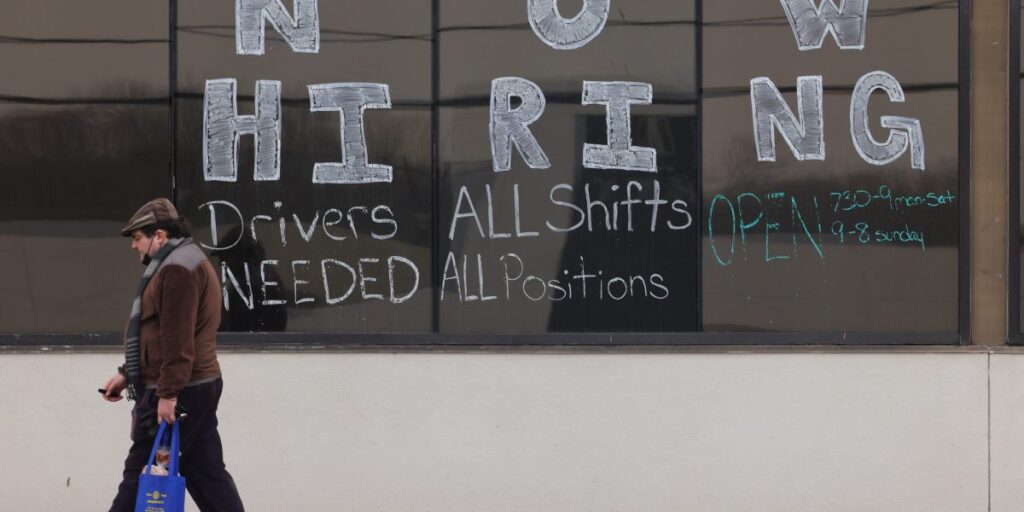America’s job growth has flatlined — and Mark Zandi believes June may have been the start of a recession
Published on September 5, 2025

The weak August jobs report reinforces a picture of a labor market that has almost entirely lost momentum.
Steve Pfost—Newsday RM/Getty Images
* Top economist Mark Zandi warned the U.S. may already be in a “jobs recession,” after new data showed just 22,000 jobs were added in August, unemployment rising to a four-year high, and June revised to the first job loss since 2020. The new data fueled bets on Fed rate cuts as political pressure mounts on the central bank.
The U.S. economy added just 22,000 jobs in August, and prior months were revised lower again, signaling a recession may have already started.
Last month’s gain was well below expectations
[https://fortune.com/2025/09/03/job-openings-jolts-lowest-nearly-a-year-labor-market/]
of about 75,000, and the unemployment rate rose to 4.3%, the highest it has been
in nearly four years, according to the Bureau of Labor Statistics.
“It’s clear the job market is struggling,” Mark Zandi, chief economist at
Moody’s Analytics, told Fortune. “The economy is on the edge of recession: In
fact, we may already be in one. As more revisions come in, it will probably show
that employment is declining in a consistent way.”
The weak August tally followed downward revisions to prior months. June was
restated to show a net job loss of 13,000—the first decline since 2020—while
July’s gain was nudged higher, leaving overall employment 21,000 lower than
previously reported.
Zandi called the June loss especially significant: “Historically, when
recessions are dated, they’re dated back to the first month of payroll declines.
That would suggest that if we are going into recession, it began in June.”
The weak showing reinforces a picture of a labor market that has almost entirely
lost momentum. Hiring in health care and social assistance provided a modest
boost, but it was largely offset by declines in federal government payrolls and
a continued weakness in the energy and manufacturing sectors.
The weakness was most pronounced on the goods-producing side of the economy.
Manufacturing shed 12,000 jobs in August, adding up to a 78,000 loss this year
to date. Wholesale trade also shed workers. Construction was flat, but Zandi
warned that the sector remains highly vulnerable.
“Manufacturing, transportation, distribution, mining, agriculture,
construction—they’re all getting hit pretty hard,” he said.
Much of that pain, he argued, stems directly from policy. Higher tariffs are
weighing on manufacturers and exporters, while immigration restrictions are
constraining the supply of workers in industries that rely heavily on
lower-skilled labor, such as construction, agriculture, retail, and hospitality.
“You can connect the dots between economic policy and the weak economy,” Zandi
said. “The trade policy—higher tariffs—and the restrictive immigration policy
are weighing heavily on the economy and lifting inflation.”
Even as health care remains a bright spot for hiring and state and local
governments continue to add jobs, the drag from goods-related industries and
federal job cuts is overshadowing those gains. Zandi cautioned that if the
slowdown tips into outright recession, job losses will broaden out from
goods-producing sectors into professional services, retail, and parts of health
care as well.
But for now, layoffs remain subdued, a dynamic Zandi described as a “firewall”
holding back a deeper downturn.
“Businesses haven’t panicked yet,” he said. “It’s just that they’ve turned more
cautious in their hiring. That firewall between a stalling economy and a
recession hasn’t been breached, but it’s very, very close.”
COOLING LABOR MARKET
The cracks in the labor market are growing harder to ignore. Long-term
unemployment has ticked higher over the past year, and more than 6 million
people outside the labor force now say they want a job, up from roughly 5.7
million about a year ago, according to the BLS.
“This really feels like a jobs recession,” Zandi said. “Employment is flat to
down. Output and incomes are still growing, but the economy is incredibly
vulnerable. Nothing else can go wrong, or it could tip us into a full downturn.”
Investors are betting the slowdown will force the Fed’s hand. The yield on the
10-year Treasury note sank
[https://www.tradingview.com/news/te_news:483239:0-10-year-treasury-yield-falls-to-5-month-low/]
to a five-month low after the release as traders priced in multiple interest
rate cuts before year-end. Zandi agreed the odds are high.
“We’ll definitely get a cut,” he said, adding that quarter-point moves in
September, October, and December are likely. “Rate cuts will help cushion
things, but they won’t save the economy. The die has been cast.”
FED INDEPENDENCE
Zandi warned that the stakes for the Federal Reserve go beyond managing
inflation and growth.
“I think the Fed desperately wants to avoid a downturn, because that will only
increase the pressure on its independence,” he said.
If the economy slips into recession, he added, the central bank could face
mounting political attacks, especially from a White House that has tried to
reshape the Federal Reserve with recent moves, such as attempting to fire
[https://fortune.com/2025/09/04/doj-opens-mortgage-fraud-probe-into-lisa-cook-source-says/]
Fed governor Lisa Cook.
“That’s their number one priority now: keep the economy out of recession. It
argues for lower rates despite the higher inflation that’s here and likely to
come.”